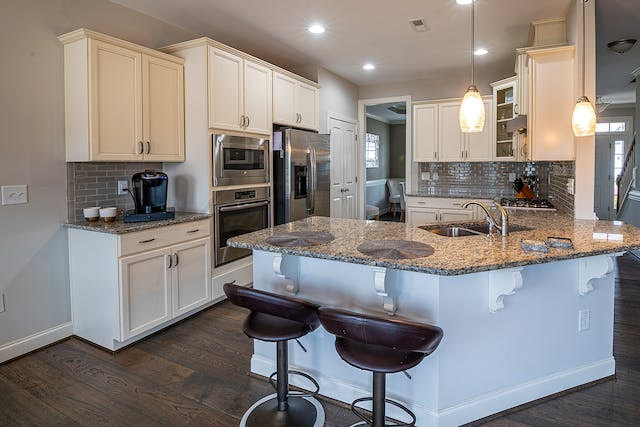Proper lighting in the kitchen is essential for creating a functional and inviting space. When illuminating the area under kitchen cabinets, you have several alternatives to regard. The right choice of under-cabinet lighting can enhance your kitchen’s aesthetics and functionality. We will explore the various lighting options available and discuss the factors to consider when determining under cabinet kitchen lighting options for kitchen cabinets.
Factors to consider when determining the best lighting
Critical factors must be considered when determining the most suitable under-cabinet lighting for your kitchen. Firstly, you must distinguish between task and ambient lighting needs, which will dictate the type of fixtures and color temperature required. The color temperature you choose plays a pivotal role in the kitchen’s ambiance and practicality, with warmer tones fostering a cozy atmosphere while cooler tones enhance visibility for tasks. Installation and wiring should also be evaluated; some options are easier for DIY installation, while others may necessitate professional assistance.
Energy efficiency is vital for environmentally conscious homeowners, with LED lighting being the most energy-efficient choice. Dimming capability can provide flexibility in setting the desired brightness levels for various activities in the kitchen. Finally, establishing a budget for your under-cabinet lighting project will help you navigate the diverse options available and make choices that align with your financial resources while achieving your lighting goals. These factors collectively contribute to selecting under-cabinet lighting that effectively illuminates your kitchen, complements its aesthetics, and meets your needs and preferences.
Lighting Options
1. LED Strip Lights:
LED strip lights are popular for under-cabinet lighting due to their versatility and energy efficiency. They come in various lengths and can be cut to fit your specific cabinet dimensions. LED strips provide even and consistent illumination, making them ideal for task lighting. They are available in warm and cool color temperatures, allowing you to choose the one that suits your kitchen’s ambiance.
Dimmable LED strips are also readily available, providing flexibility in lighting intensity. LED strip light installation is relatively straightforward, and many models come with adhesive backing for easy attachment to the cabinet’s underside. Nevertheless, it’s paramount to ensure proper wiring and consider using a transformer or driver to convert the voltage and prevent flickering or overheating.
2. Puck Lights:
Puck lights are small, round fixtures that can be surface-mounted or recessed under cabinets. They offer focused illumination, making them suitable for task lighting, such as highlighting countertops or providing additional light over the stove. Puck lights come in various designs and finishes to match your kitchen’s style. While puck lights are relatively easy to install and can be wired together for a cohesive look, they may create shadows and uneven lighting if not spaced properly. Additionally, some puck lights may not be dimmable, so checking the specifications before purchase is paramount.
3. Linear fluorescent lights
Linear fluorescent lights, such as T5 or T8 fixtures, have been traditionally used for under-cabinet lighting. They deliver bright and even illumination, assembling them suitable for tasks. These fixtures are known in diverse lengths and can be hardwired for a seamless look. One drawback of linear fluorescent lights is their color temperature, which tends to be cooler. This can be a disadvantage if you prefer warmer lighting in your kitchen. Additionally, fluorescent lights are less energy-efficient than LED alternatives and may require more frequent bulb replacements.
4. Xenon Lights:
Xenon under-cabinet lights are known for their warm and natural color temperature, similar to incandescent bulbs. They emit a soft and flattering glow, making them a popular choice for kitchens where ambiance is a priority. Xenon lights are available in puck or linear strip forms and can be dimmed for versatility. While xenon lights offer excellent color rendering and ambiance, they are less energy-efficient than LED options and can generate more heat. Careful consideration of ventilation and heat dissipation is necessary when installing xenon lights to prevent overheating and potential damage to cabinets.
5. Battery-Powered Lights:
Battery-powered under-cabinet lights are a convenient option, eliminating the need for wiring and electrical installation. These lights are oftentimes equipped with motion sensors or touch controls, making them easy to operate. Battery-powered lights can be placed anywhere under the cabinets, providing flexibility in positioning. Nevertheless, battery-powered lights may demand frequent battery replacements, and their brightness may diminish over time. They are best suited for temporary or small-scale lighting needs.
Selecting the best lighting for under kitchen cabinets involves careful consideration of your kitchen’s specific requirements and personal preferences. LED strip lights offer versatility, energy efficiency, and dimming capabilities, making them popular for task and ambient lighting. Puck lights are suitable for focused illumination but should be spaced strategically to avoid uneven lighting. Linear fluorescent lights provide bright and even illumination but have a cooler color temperature and may require more maintenance.




Comments are closed.